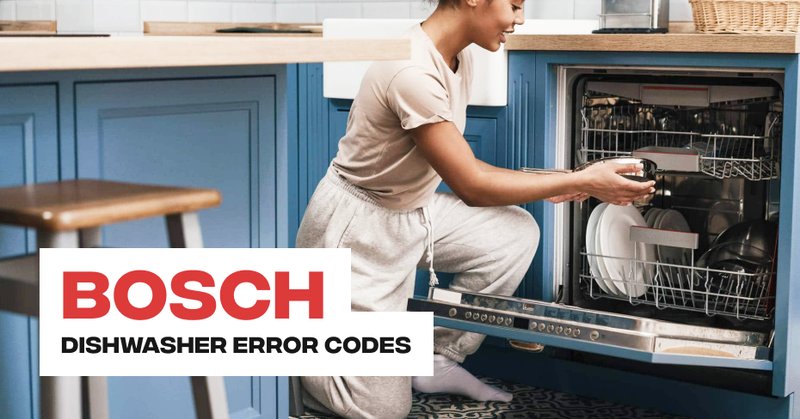
When a dishwasher, much like any other appliance, starts to show an error code, it’s essentially trying to communicate with you, like a person raising a red flag. Error Code F1 on a Bosch dishwasher is no exception. It’s the machine’s way of alerting you to a potential problem that might require your attention. Ignoring a warning from your dishwasher is akin to ignoring the oil light on your car dashboard—sometimes it’s a minor issue, but other times it could lead to a bigger problem down the road. So, before you decide to turn a blind eye, let’s dive deep into what this error code is all about.
Understanding Error Code F1
Error Code F1 generally points to a problem related to water issues in your Bosch dishwasher. Simply put, it’s your dishwasher telling you that it has detected water where it shouldn’t be. In many models, F1 indicates a flood condition, usually involving water accumulating in the dishwasher base or a leakage issue. Think of it like when you leave a window open during a rainstorm; water ends up where it doesn’t belong.
This code can be triggered by several things. It might be caused by a clog, a faulty component, or even a door seal that isn’t sealing properly. In some cases, the issue could be a simple oversight, such as forgetting to properly close the dishwasher door or loading the dishes in a way that obstructs water flow. Regardless of the reason, it means your dishwasher senses something is off and needs you to take action to prevent potential water damage.
Here’s the deal: When Error Code F1 pops up, ignoring it could result in water leakage, which might affect not only your dishwasher but also the surrounding cabinetry and flooring. It’s like ignoring a minor leak in your roof – it could lead to expensive repairs if left unattended.
Causes of Error Code F1
To really understand why your Bosch dishwasher might be showing Error Code F1, it helps to know what might cause it. One of the most common reasons is a leak. This could be due to a worn-out door seal that allows water to escape, or even a crack in the dishwasher’s base. Imagine trying to fill a cracked bucket with water; it just won’t hold up.
Another typical cause might be a faulty water inlet valve. If this valve doesn’t function properly, it can either prevent water from entering the dishwasher or allow too much water in, leading to flooding conditions. Think of it as a clogged faucet; it can either trickle or gush uncontrollably.
You might also find that the float switch, a small device responsible for detecting the water level in your dishwasher, is malfunctioning. If it’s stuck or broken, it might not signal the machine to stop filling with water, leading to overflow. Just like a stuck gas pedal in a car, this could quickly lead to an unwanted situation.
If you spot or suspect any of these issues, it’s wise to dig a little deeper or call in a professional to prevent further complications. In the meantime, you can manually check for visible leaks under and around the dishwasher and see if any parts need replacement.
Can You Ignore This Error?
You might be wondering if it’s really necessary to address this error right away. In short: no, it’s not advisable to ignore Error Code F1. Doing so can lead to more extensive damage and costly repairs. Just like neglecting to change a car’s oil could lead to an engine breakdown, ignoring this error could mean more trouble in the long run.
While some might think that if the dishwasher seems to be working, it’s okay to keep using it, this isn’t the best idea. Behind the scenes, unnoticed water damage might be occurring, affecting not only the dishwasher but your home environment as well. Water damage can lead to mold growth or structural damage over time, which is certainly best avoided.
Addressing Error Code F1 promptly can save you from these unwanted headaches. Consider it an opportunity to ensure your dishwasher is in top working condition, much like doing a routine check-up at the doctor’s office. If troubleshooting doesn’t resolve the issue, reaching out to Bosch customer service or a certified technician should be your next step.
Next Steps and Troubleshooting
Okay, so now you know it’s not a great idea to ignore this error. What should you do next? Start by turning off the dishwasher and disconnecting the power to prevent further water accumulation. Safety is key, so ensuring there’s no electricity running to the dishwasher is crucial before proceeding with any checks or repairs.
Check for any visible leaks around the dishwasher. If you have access, look under the appliance for signs of water pooling or damage. If you feel comfortable, inspect the door seal and ensure it’s intact and forming a proper barrier. Like checking your doors for drafts in winter, you’re ensuring everything is tightly sealed.
For more complex components like the float switch or the water inlet valve, referring to your dishwasher’s manual can provide guidance on troubleshooting these parts. If you’re not sure, contacting a professional can be a lifesaver. They can offer a thorough diagnosis and suggest the best course of action to bring your dishwasher back to its optimal state.
Taking these steps not only resolves the immediate issue but can also extend the lifespan of your appliance, ensuring your Bosch dishwasher continues to serve you well without unexpected surprises.